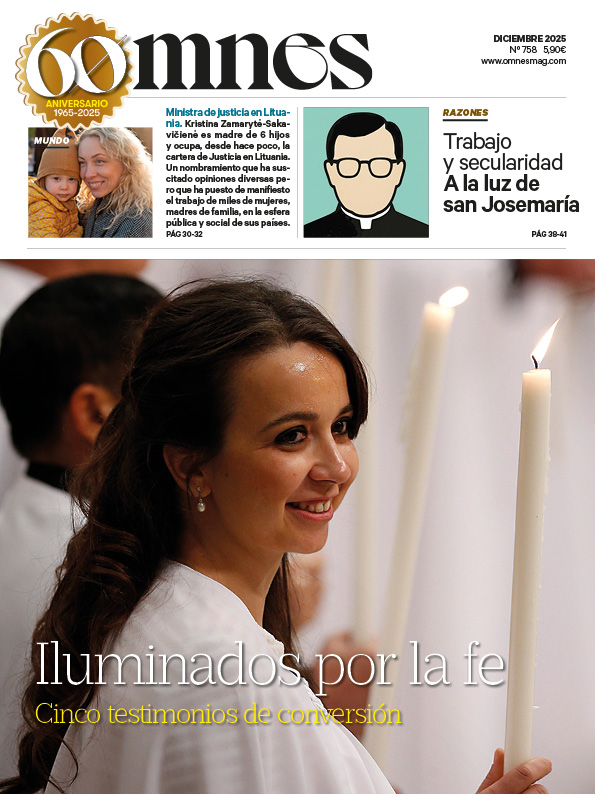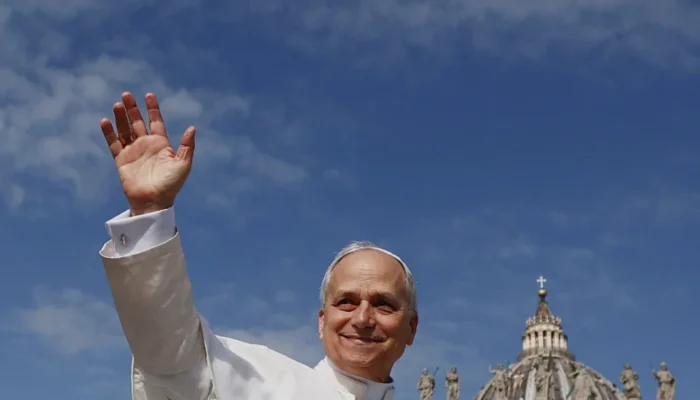When I went to Spain in January to present a film project on the life of Santo Toribio de Mogrovejo, I had the opportunity to visit Mayorga, a small and beautiful town, where Santo Toribio de Mogrovejo was born. I was able to see the church built in what used to be the saint's house.
In the municipality, presided by the mayor David de la Viuda Rodríguez, we made a small presentation of what would be the feature film that "Goya Producciones" would make about the life of Santo Toribio. Then we strolled through the streets of this friendly town. I talked with the mayor, as I had talked before with other people in Spain, about the intention of achieving a twinning between Mayorga and (Zaña) Peru.
Some members of the "Asociación Católica de Propagandistas" told me about the release of an interesting film called "Hispanoamérica", which promotes, with wonderful interviews and formidable arguments, the twinning of Spain with Latin America, erasing the black legends that some pseudo historians and Marxist politicians had written throughout history, as if Spain was aggressive and ambitious with the lands of the indigenous population.
Brief history of Mayorga
Mayorga, in Valladolid, has a history that dates back to pre-Roman times, with roots in the "Ancient Vaccean city of Meóriga". In the Middle Ages, it became a strategic point on the border between Castilla and León, forming part of the possessions of important noble families. Over the centuries, Mayorga has witnessed important events, including the reign of Fernando II of León and his son Alfonso IX.
On November 16, 1538, Toribio Alfonso de Mogrovejo was born in Mayorga. In 1578, Philip II signed the Royal Cellula presenting the new archbishop to Pope Gregory XIII. After obtaining various assignments, he was named archbishop of the City of the Kings of Peru, Lima and of the archdiocese of South America. A fighter to defend the Indians, he also baptized them, traveling more than 40,000 kilometers by mule or on foot. He elaborated a catechism in Spanish, Quechua and Aymara, so that the Indians could understand it.
The town of Mayorga celebrates two festivities in honor of Saint Toribio: the first one on April 27, on the occasion of the transfer of his body to the Cathedral of Lima; the second one is the patron saint festivities on September 27, called Fiesta de las Reliquias, the day when the relics arrived in Mayorga. These were received with large lit torches and, as a reminder of that date, the tradition of the Civic Procession of the Vitor, declared of national tourist interest, has been perpetuated.
The town of Zaña
Zaña, located in the Lambayeque region of Peru, was a prosperous city known as the "Peruvian Seville" before it was sacked and destroyed by pirates and later by floods. Its history is rich in opulence, plunder, and a legacy that is preserved in its ruins and Afro-Peruvian community.
It was founded as Santiago de Miraflores de Zaña in 1563. Such was its growth and development that in the 17th century it rivaled the city of Trujillo in importance.
Zaña was recognized by the Peruvian Ministry of Culture as a "Living Repository of the Afro-Peruvian Collective Memory", for being one of the nuclei of the historical and artistic memory of the Afro-Peruvian presence in Peru. Likewise, in 2017 it was declared by Unesco as a "Site of the Memory of Slavery and African Cultural Heritage".
It was founded on November 29, 1563 with the name of Villa Santiago de Miraflores de Saña during the colonizing period by Captain Baltasar Rodriguez, due to its excellent location halfway between the sea and the mountains, the good irrigation system that the Indians had made there and for having a river very close to whose banks they built huge churches and mansions.
Being in the center of a network of commercial routes made the town become an opulent city, so much so that it is said that it almost became the capital of the country. One of the reasons why Zaña was chosen was because the best port in the area is located in the Chérrepe creek and trade to the highlands passed through the Zaña valley. The old road to Cajamarca probably went up that valley and not through one of the rivers of the Lambayeque system.
During the viceroyalty, the Spaniards brought black slaves for agricultural and service work. In 1604 Lizárraga reported that Zaña was "very abundant, where from a few years to this part a town of Spaniards of no small contracting has been populated, for the sugar mills and cordobanes corambre and for the many flours that are extracted from it for the kingdom of Tierra Firme".
At the beginning of the 17th century, Vázquez de Espinosa described the town of Zaña as having a cathedral, convents of the Dominican, Franciscan and Augustinian orders, other churches and a hospital. The town was bustling with commercial activities: sugar and leather products and canned goods were sent to other parts of Peru; wine, wheat, corn and other agricultural products were also exported.
During this period Zaña, which by then was called the "Seville of Peru" or "Little Potosí" (according to historian Hampe Martínez), attracted the English privateer Edward Davis, who invaded the city in 1686, entered it after overcoming a weak resistance and together with his men sacked churches and houses, raped women and took a great amount of wealth. As a result, many of its inhabitants opted to migrate to Lambayeque, Ferreñafe and Túcume.
After that Zaña managed to recover, but unfortunately on March 15, 1720 a flood occurred, the waters of the Zaña River left its course and attacked the city with great force, destroying everything in its path. This event was considered as a "divine punishment" similar to the one experienced by Sodom and Gomorrah, because of the pagan rites and orgies celebrated by the population.
Then came a large immigration of Japanese and Chinese to work in the sugar plantations that remained after their contracts were fulfilled, to open small bodegas and grocery stores.
Zaña came to have seven temples of the baroque style very ornate, but currently only four of them are preserved: La Merced, San Agustín, San Francisco and the Iglesia Matriz. The Church and Convent of San Agustín represents one of the few examples of Gothic architecture remaining in Peru.
On May 12, 1581, Santo Toribio entered Lima. From the first day he left for Nazca to get to know the southern part of his diocese and then went up to Huanuco to complete his knowledge of the highlands. Thus began his journey as a father and shepherd through the hills, crossing rivers, suffering the heat of the northern coast, the icy punas and the nebulous nooks and crannies of the mysterious jungle. Thus, town after town, without rest or fatigue, always breaking down walls, tearing down gaps and opening roads to the steady rhythm of his apostolic footsteps, "without paying attention to anything but the service of Our Lord...".
The first steps of a twinning
A) The presentation of a motion by the mayor of Zaña, to the plenary session of the Board of Aldermen to approve at the level of the municipality the steps that are being taken for the twinning. There will also be proposed the acceptance of two committees:
1) Committee to achieve the signing of the Sisterhood Agreement between Mayorga and Zaña: composed of the Mayor of Zaña, the Manager of the Municipality, and Rita Vigil to support the efforts. It will be in charge of completing the necessary documentation and requirements.
2) Support committee: it is planned to appoint a support committee (in addition to those indicated in 1) to be in charge of proposing and monitoring the actions to be carried out at the district level. This committee will be composed of distinguished people from the town of Zaña.
3) To make the population aware of the importance of this twinning and what the celebration of Santo Toribio entails, emphasizing the faith and devotion they have to their Patron Saint of the city: to achieve the participation of schools and local institutions.
4) To promote that the riches that Zaña has, with its history (it was founded by the Spaniards as the Villa de Santiago de Miraflores, it was one of the most important cities of the Viceroyalty). It has ruins of the great churches and Convents and the place where the remains of Santo Toribio rested.
5) Its gastronomy and folklore.
In addition, with the route that is being taken from the Pope Leo XIVThe regional government has considered Zaña as a possible destination, which would help to recognize its importance.
Peruvian priest








